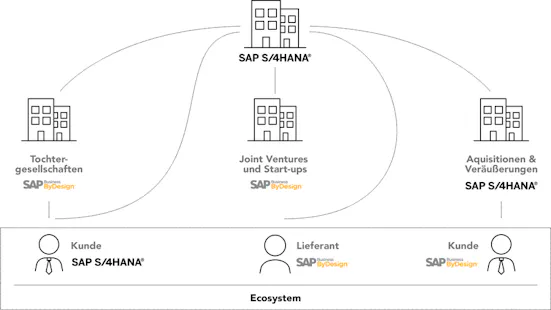
Carve-outs & connections
with the 2-tier strategy
Whether carve-in, carve-out, start-up, scale-up, joint venture, the integration of subsidiaries or the merger of companies - the new unit must be operationally capable of acting quickly. With the SAP S/4HANA Cloud, public edition, strategic, operational, legal and technical challenges can be mastered efficiently and future-proof.
The entire company benefits from standardized processes, better planning, integrated control and smooth collaboration. At the same time, the local unit remains flexible and sufficiently independent. Implementation takes place quickly - without the need for in-house IT resources or hardware investments. Thanks to the flexible subscription model, IT costs are reduced while SAP takes care of maintenance, updates and security.
"Smaller companies often don't need the functional depth of the systems of corporate headquarters."
Challenges with carve-outs
1. strategic challenges
- Clear demarcation: Which units, contracts and assets belong to the carve-out?
- Value maximization through attractive market positioning.
- Sustainable, independent structure (e.g. IT, organization, finance).
2. operational challenges
- Central processes such as HR or finance must be restructured.
- Employee retention and communication are crucial to success.
- Contracts need to be reviewed, transferred or redrafted.
3. technological/IT challenges
- ERP, CRM & Co. must be cleanly separated or duplicated.
- Data migration must be correct and GDPR-compliant.
- No transitional solutions are necessary due to the rapid introduction.
4 Financial and legal challenges
- Own balance sheet, accounting and possibly banking structure required.
- Tax implications must be taken into account.
- Clarify regulatory requirements depending on the industry.
5 Time and resource management
- High project complexity with many dependencies.
- Day-to-day business continues parallel to the separation.
Challenges in connecting subsidiaries
- Company growth is outpacing the speed at which the existing system landscape can be adapted.
- The administrative effort for the ERP system is becoming increasingly cost-intensive and tying up valuable resources.
- Subsidiaries need to be efficiently integrated into the existing SAP landscape.
- There is a lack of infrastructure, personnel resources and time for implementation and integration.
Typical use cases for the connection of subsidiaries
Local sales organization
Sales and logistics organization
Local customer service
Shared service unit
Services, consulting, engineering
2-tier strategy explained simply
The company headquarters (Tier 1) uses a fully comprehensive ERP system, e.g. SAP S/4HANA. Subsidiaries or business units (Tier 2) are connected with a lean, cloud-based ERP solution such as SAP S/4HANA Cloud, public edition - quickly, cost-effectively and integrated into the existing system landscape.
Why a 2-tier strategy?
What does 2-tier strategy with cloud ERP actually mean?
What are the advantages of a 2-tier strategy integration?
Advantages for the company headquarters
- Standardized database for improved strategic planning and control
- Standardized and uniform processes
- Increased cost control
- Better collaboration throughout the company

Advantages for the new unit
- Adaptability to corporate requirements and business processes
- Greater global reach while meeting local requirements
- Ability to adopt best practices
- Reduction of complexity resulting from ERP usage
- Fast and cost-effective implementation
- No local IT infrastructure required
- Fixed monthly rental price
- User-based costs
- Mobile use - always and everywhere
Do you have any questions?
Our cloud ERP expert will be happy to support you - personally, competently and practically. Arrange a non-binding consultation now.

Request advice
About All for One
All for One is the number one SAP partner in the German-speaking SME market with more than 3,500 customers in Germany, Austria and Switzerland.
Our experts go to work every day with great commitment, passion and know-how, making All for One a strategic partner for SAP, IT and business.






